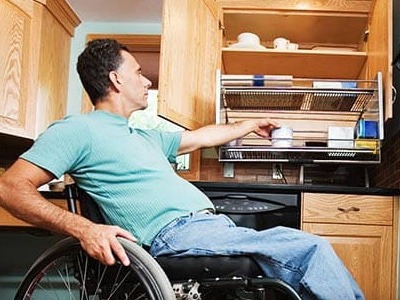Getting the Right Tools
In order to navigate in your home with ease, proper equipment is needed to help you get through the day. Any room in your home can be a potential risk for falling and injury. Staircases can reduce or even impede movement between floors due to the risk of falling. Luckily there are products out there that can help mitigate the issues you face.
Staircases
If you have trouble going up the stairs you can use a stair lift or a vertical platform lift to help get you up/down the staircase. Each option has its own strengths and weaknesses making the decision more specific to the situation. For example a stair lift takes up much less space than a wheelchair lift does, making it less obstructive in the home. However, a VPL is a better option when you are wheelchair bound since the lift can carry both you and the wheelchair.
The same could be said for the front or backyard of your house. The outside of your home may have more space than the inside making a VPL a more viable option than having one inside. A wheelchair ramp can also be considered for outside since it is more cost effective and requires very little to no construction of your home. Depending on the handicap ramp you can even customize its look based on your personal preference.
Bathroom
Some of the rooms in your home present much larger dangers than others. For example your bathroom has slippery floors, making movement a potential risk especially for those with limited mobility. Some ways to combat against the slippery nature of the bathroom floor is through the use of non-slip shower mats. These bathroom mats, as the name implies, minimize the chance of slipping and falling in the shower. For extra precautions, a hard bar can be installed in your shower for extra grip or even a shower seat if necessary. You can even install the shower seat to ensure your safety.
Elevated Rooms
Some parts of your home such as your garage or living room may not have a large staircase yet a small amount of steps. Rooms that have a small step or 2 in the entrance can present the same risk that going up your staircase can, albeit there are less steps to take. Those 2 steps may seem minimal compared to your staircase, however it is just as important to prepare for them for lowering the chance of falling. A handrailing on the side of the steps can make it much safer to use. If you are wheelchair bound, then a small wheelchair ramp (preferably a foldable ramp or threshold rampcan help you enter and exit a room.
General Safety
One big cause for falling in your home is simply not seeing what is on the floor that you slipped or tripped on. Proper lighting for your home is a good countermeasure for falling in your home. Clearing any obstructions from the floors and stairs also minimizes your risk of injury. Another precaution to take is avoiding to put items you need on high shelves and/or on top of furniture. One last thing to do is to add a rug or carpet to lower the risk of slipping onto the floor.
Having the Right Attitude
Equally as important as the right equipment is having a positive mindset. Being optimistic and vigilant allows you to better plan ahead and make sure you don’t skip over the small details that could matter later down the line.



